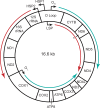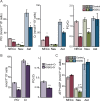Mitochondrial DNA depletion by ethidium bromide decreases neuronal mitochondrial creatine kinase: Implications for striatal energy metabolism
- PMID: 29287112
- PMCID: PMC5747477
- DOI: 10.1371/journal.pone.0190456
Mitochondrial DNA depletion by ethidium bromide decreases neuronal mitochondrial creatine kinase: Implications for striatal energy metabolism
Abstract
Mitochondrial DNA (mtDNA), the discrete genome which encodes subunits of the mitochondrial respiratory chain, is present at highly variable copy numbers across cell types. Though severe mtDNA depletion dramatically reduces mitochondrial function, the impact of tissue-specific mtDNA reduction remains debated. Previously, our lab identified reduced mtDNA quantity in the putamen of Parkinson's Disease (PD) patients who had developed L-DOPA Induced Dyskinesia (LID), compared to PD patients who had not developed LID and healthy subjects. Here, we present the consequences of mtDNA depletion by ethidium bromide (EtBr) treatment on the bioenergetic function of primary cultured neurons, astrocytes and neuron-enriched cocultures from rat striatum. We report that EtBr inhibition of mtDNA replication and transcription consistently reduces mitochondrial oxygen consumption, and that neurons are significantly more sensitive to EtBr than astrocytes. EtBr also increases glycolytic activity in astrocytes, whereas in neurons it reduces the expression of mitochondrial creatine kinase mRNA and levels of phosphocreatine. Further, we show that mitochondrial creatine kinase mRNA is similarly downregulated in dyskinetic PD patients, compared to both non-dyskinetic PD patients and healthy subjects. Our data support a hypothesis that reduced striatal mtDNA contributes to energetic dysregulation in the dyskinetic striatum by destabilizing the energy buffering system of the phosphocreatine/creatine shuttle.
Conflict of interest statement
Figures








Similar articles
-
Striatal Nurr1 Facilitates the Dyskinetic State and Exacerbates Levodopa-Induced Dyskinesia in a Rat Model of Parkinson's Disease.J Neurosci. 2020 Apr 29;40(18):3675-3691. doi: 10.1523/JNEUROSCI.2936-19.2020. Epub 2020 Apr 1. J Neurosci. 2020. PMID: 32238479 Free PMC article.
-
A low dose of ethidium bromide leads to an increase of total mitochondrial DNA while higher concentrations induce the mtDNA 4997 deletion in a human neuronal cell line.Mutat Res. 2006 Apr 11;596(1-2):57-63. doi: 10.1016/j.mrfmmm.2005.12.003. Epub 2006 Feb 20. Mutat Res. 2006. PMID: 16488450
-
Mitochondrial homeostatic disruptions are sensitive indicators of stress in neurons with defective mitochondrial DNA transactions.Mitochondrion. 2016 Nov;31:9-19. doi: 10.1016/j.mito.2016.08.015. Epub 2016 Aug 28. Mitochondrion. 2016. PMID: 27581214
-
Mitochondria and diabetes. Genetic, biochemical, and clinical implications of the cellular energy circuit.Diabetes. 1996 Feb;45(2):113-26. doi: 10.2337/diab.45.2.113. Diabetes. 1996. PMID: 8549853 Review.
-
Plausible Role of Mitochondrial DNA Copy Number in Neurodegeneration-a Need for Therapeutic Approach in Parkinson's Disease (PD).Mol Neurobiol. 2023 Dec;60(12):6992-7008. doi: 10.1007/s12035-023-03500-x. Epub 2023 Jul 31. Mol Neurobiol. 2023. PMID: 37523043 Review.
Cited by
-
Prohibitin 1 regulates mtDNA release and downstream inflammatory responses.EMBO J. 2022 Dec 15;41(24):e111173. doi: 10.15252/embj.2022111173. Epub 2022 Oct 17. EMBO J. 2022. PMID: 36245295 Free PMC article.
-
Mitochondria in Early Forebrain Development: From Neurulation to Mid-Corticogenesis.Front Cell Dev Biol. 2021 Nov 23;9:780207. doi: 10.3389/fcell.2021.780207. eCollection 2021. Front Cell Dev Biol. 2021. PMID: 34888312 Free PMC article. Review.
-
Hexokinase dissociation from mitochondria promotes oligomerization of VDAC that facilitates NLRP3 inflammasome assembly and activation.Sci Immunol. 2023 Jun 23;8(84):eade7652. doi: 10.1126/sciimmunol.ade7652. Epub 2023 Jun 16. Sci Immunol. 2023. PMID: 37327321 Free PMC article.
-
Techniques for investigating mitochondrial gene expression.BMB Rep. 2020 Jan;53(1):3-9. doi: 10.5483/BMBRep.2020.53.1.272. BMB Rep. 2020. PMID: 31818361 Free PMC article. Review.
-
A roadmap for ribosome assembly in human mitochondria.Nat Struct Mol Biol. 2024 Dec;31(12):1898-1908. doi: 10.1038/s41594-024-01356-w. Epub 2024 Jul 11. Nat Struct Mol Biol. 2024. PMID: 38992089 Free PMC article.
References
-
- Bak LK, Schousboe A, Waagepetersen HS. The glutamate/GABA‐glutamine cycle: aspects of transport, neurotransmitter homeostasis and ammonia transfer. J Neurochem. 2006;98(3):641–53. doi: 10.1111/j.1471-4159.2006.03913.x - DOI - PubMed
-
- Westergaard N, Sonnewald U, Schousboe A. Metabolic Trafficking between neurons and astrocytes: the glutamate/glutamine cycle revisited. Dev Neurosci. 1995;17(4):203–11. - PubMed
-
- Pellerin L, Bouzier‐Sore A, Aubert A, Serres S, Merle M, Costalat R, et al. Activity‐dependent regulation of energy metabolism by astrocytes: An update. Glia. 2007;55(12):1251–62. doi: 10.1002/glia.20528 - DOI - PubMed
Publication types
MeSH terms
Substances
Grants and funding
LinkOut - more resources
Full Text Sources
Other Literature Sources
Miscellaneous

